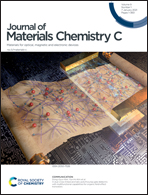A highly efficient and thermally stable broadband Cr3+-activated double borate phosphor for near-infrared light-emitting diodes†
Abstract
Highly efficient and thermally stable broadband near-infrared (NIR) phosphors are urgently required for phosphor-converted light-emitting diodes (pc-LEDs), which are compact, low cost and promising for applications such as food analysis and agricultural science. Herein, a NIR phosphor, GdAl3(BO3)4:Cr3+ (GAB:Cr3+), with high emission efficiency and excellent thermal stability is presented. Under blue light excitation, GAB:Cr3+ shows a broad emission band covering 650–1000 nm with a full width at half maximum of ∼140 nm. Particularly, the 1.0 at% Cr3+ doped sample exhibits a photoluminescence (PL) quantum yield as high as 91%, and no decline of the PL intensity is observed even when the temperature is raised from 298 to 423 K. By combining the GAB:Cr3+ phosphor with a commercial blue LED chip, a high-performance NIR pc-LED is fabricated with a NIR radiant flux of 81 mW under a drive current of 350 mA. Furthermore, an aging test was performed on this device at 85 °C and 85% humidity for 480 h, and the radiant flux retained up to 95% of its initial value, which is comparable to the commercial phosphors. These results suggest that GAB:Cr3+ is a promising candidate for broadband pc-LEDs in NIR spectroscopy applications.

- This article is part of the themed collections: Journal of Materials Chemistry C Lunar New Year collection 2022 and 2021 Journal of Materials Chemistry C most popular articles


 Please wait while we load your content...
Please wait while we load your content...